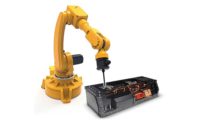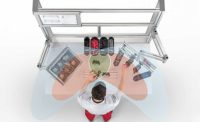True or false: A few clicks of a mouse can ensure zero-defect manufacturing as well as—if not better than—using the right fastener, adhesive or welding process. Increasingly, manufacturers of all sizes are answering “true.”
One such company is TS Tech Americas Inc., a Tier 1 supplier of seats and door panels to U.S.-based Honda plants. It has used Tutelar Technologies Inc.’s Ujigami software since 2008 to drive zero defects. This high level of performance enabled TS Tech Americas’ parent company, TS Tech Co. Ltd., to earn the No. 1 ranking for seat quality in the 2012 J.D. Power & Associates U.S. Seat Quality and Satisfaction Survey. Equally important, the software increases plant productivity by 12 to 15 percent and significantly lessens waste.
Another manufacturer benefiting from software is Shannon Precision Fasteners LLC, based in Madison Heights, MI. Shannon makes 1.6 million cold-headed fasteners per day for the Big 3 automakers and several large Tier 1 suppliers.
Founded in 2004, the company increased its focus on quality in late 2008 to retain their automaker customers as they downsized. Last year, the company began using Quality Intelligence (QI) and Vision Intelligence (VI) software, made by Sight Machine, to help workers determine good and bad fasteners with greater accuracy.
VI displays a scan of a fastener made by an attached document scanner. QI immediately performs grainflow analysis of the fastener to spot defects. The software also analyzes other data—such as bearing surface diameter and concavity, and compression area clearance—to verify that the fastener meets customer specifications.
“The software removes measurement variation from our manufacturing processes,” claims Bob Allison, quality manager for Shannon Precision Fasteners LLC. “It gives the people that run our equipment the best possible data to make the right decision.”
Technology Transforms the Plant Floor
Software for manufacturing has undergone a paradigm shift in recent years. MES (manufacturing execution system), SPC (statistical process control) and OEE (overall equipment effectiveness) software remain popular because they are a reliable way to monitor and optimize assembly processes. But, the goal of newer software is zero-defect manufacturing.
“Process reporting is important, but it only provides a likelihood that parts will be good in the future,” says Floyd Dickson, vice president of sales for Tutelar Technologies. “To guarantee good parts, the software must be able to coordinate and control all manufacturing activities as each part is being produced.”
But, what’s the driving force behind the development and acceptance of zero-defect software? Dan McKiernan, president of eFlex Systems, points to evolving technologies, particularly mobile devices and apps.
“Many of our customers no longer want desktop computers or even HMI screens on the plant floor,” notes McKiernan. “They want kiosks and mobile devices that are capable of using simple browsers.”
He says one customer, a transmission gear manufacturer, runs eFlex Quality traceability software on one kiosk and several mobile devices. Plant-floor workers use the devices to track totes full of gears as they move through the process. The software provides real-time tracking and status information on the totes, including how many gears are in each tote and which gears pass or fail quality specifications.
“We’re in a post-PC era,” claims Rick Caldwell, president of SCADAware. “Plant managers love tablets, iPads and apps because they literally give them the information they need at their fingertips at any moment.”
Caldwell points out that one of his automotive-part-supplier customers has replaced individual PCs in workstations with one iPad per assembly line. Using an app that runs SCADAware’s StatusWatch software, the device continually updates data and graphics for all assembly line activities, including machine uptime and downtime, and the ratio of good to bad parts.
Dickson considers intelligent plant floor devices, and their standard Ethernet communication capability, the primary technology enabler for manufacturers to achieve zero defects. He also acknowledges the importance of increasing data-transmission speeds and storage capabilities, along with the falling prices of computer servers and monitors.
Reconfigure and Rebalance
A well-known tradition of the auto industry is the partial or total shutdown of plants during the first two weeks in July to retool for the new model year. Some downtime is reserved for starting up the new lines so they’re running smoothly when workers return.
George Jewell, vice president of eFlex Systems, says several automakers use eFlex Assembly process management software to quicken assembly line reconfiguration and startup. Since its introduction in 2006, eFlex Assembly has been installed in 32 auto plants around the world.
“To remain competitive, manufacturers need software that increases plant floor flexibility,” explains Jewell. “They must be able to handle increasing product variation, rerate lines for changing demand and redeploy capital for new products.”
To achieve zero-defect manufacturing, the software integrates workstations to ensure that each part is error free before it is released to the next station. This enables a manager to locate the stations causing quality issues within the assembly process. Once a change is made to improve quality, the software’s Process Improvement Tool (PIT) automatically determines how the change impacted line cycle time and efficiency.
The PIT also obtains and analyzes real-time task-level data for every station on an assembly line. Manufacturers use this tool as needed, be it continuously, periodically or for a specific event, such as a recent line change.
The software’s Process Configuration Tool (PCT) ensures smooth launching of new products on an existing or a new assembly line. Product launches on a traditional assembly line are sometimes delayed due to reconfiguration, which includes redefining and hard coding each station on the line. The PCT eliminates delays because it provides a central location where a line can be reconfigured in hours without recoding or stopping operations.
For a new line, the PCT enables manufacturers to develop the line and product simultaneously. This approach saves considerable time compared to the traditional method of developing the product and then clarifying each station prior to building the assembly line.
GPS for Each Part
For nearly two years, Chrysler Group LLC has operated and expanded its World Class Manufacturing (WCM) Academy in Warren, MI. There, Chrysler employees learn about the 10 technical pillars of WCM and work with the latest tools and technology. This year Ujigami software was included in the technology discussions.
“Assembly is a serialization of parts or products, each of which is unique,” says Dickson. “Our software recognizes this reality and gives each part or product 100 percent attention and its own GPS, so to speak.”
Ujigami integrates all manufacturing functions—from receiving orders and raw material, to shipping of the final product. Because it works on any Web browser on any computer or mobile device, manufacturers can select the hardware that is best for them and always be connected to the plant floor from anywhere. The software supports all types of real-time sensors and equipment, including PLCs, pick-to-light, part presence, vision and color detection.
“So many manufacturers operate islands of automation with their software,” explains Dickson. “We create bridges that link together all the assembly processes.”
Zero-defect manufacturing is achieved by controlling common cause variation and preventing special cause (unexpected) variation. The software enables authorized users to set requirements and define process sequencing for each part, model and option. It integrates easily with part-measurement devices that immediately identify process errors and material defects.
When a bad part is identified, the operator is immediately notified and provided graphical work instructions to correct it. The software tracks this part to ensure that corrective actions are performed and, if not, that the part is not further processed.
Web-based reporting provides up-to-the-second status information that highlights production and quality concerns before they affect shipping schedules. It also enables the software to operate continuously without maintenance or support and with minimal computing resources.
Dickson says the software is flexible and scalable, allowing users to easily make changes and rebalance lines. Other capabilities include automation control, downtime tracking, inbound and outbound sequencing, labeling and production reporting.
More Intelligence
Improving manufacturers’ product quality is the sole reason software supplier Sight Machine exists, according to Jon Sobel, CEO and co-founder. The 2-year-old company makes Quality Intelligence (QI), a Web-based software program designed to help manufacturers make the most use of images and quality-related data obtained by smart cameras and sensors.
“Usually, the storage limitation of the camera or sensor requires the images and data to be erased after a pass-fail decision is made,” notes Sabel. “We store both on a remote server and analyze them in real time to provide insights on why a part or product failed.”
The software enables a manufacturer to quickly search and filter the server for specific images and data, which can then be easily shared across operations within in a plant or sent to outside customers. QI logs each search for future reference.
Sobel says the software automatically produces charts based on the data, similar to statistical process control software. When data trends indicate a possible problem with part or product quality, managers are immediately notified via customized email and text alerts. The software is camera-agnostic and facilitates additional testing of stored images.
Recently, a Big 3 automaker installed QI to enhance a multi-camera vision system in an inspection station. The OEM uses the software to verify that the correct-color fender is on each vehicle.
“At another plant, QI checks five locations on each vehicle to make sure all the correct parts are there,” says Sobel. “The software does this in real time while analyzing thousands of possible permutations.”
Keeping Watch
SCADAware’s original software provided a fixed number of generic reports summarizing asset utilization and plant efficiency. That changed in 2005 when a major construction-equipment manufacturer met with president and founder Rick Caldwell to discuss how the software could be tweaked to produce custom reports. Soon after, StatusWatch was developed.
Caldwell says today there are more than 3,600 installations of StatusWatch in 75 plants located in nine countries. He claims that, on average, the Web-based OEE software can improve a plant’s efficiency by 20 percent on the first pass.
Customized reports graphically display the activity of assets and require no programming. Flexible time filtering refines reports to specific information covering a specific time frame.
“StatusWatch provides key data in real time, such as the ratio of good to bad parts and machine uptime,” explains Caldwell. “An entire company can access this data via any standard Web browser because the software allows unlimited free clients.”
Data is automatically extracted from machines, tools and the company’s StatusLight Andons, or input manually. When the data indicate the need for action, managers receive triggered notifications. If the triggers go unanswered, StatusWatch allows appropriate users to respond immediately.
“There are lots of software products out there, and it can be hard to pick the right one,” summarizes Caldwell. “Manufacturers need to decide more than which data they want and how to acquire it. Someone in operations management must be involved and be interested in getting better by acting on the data.”







